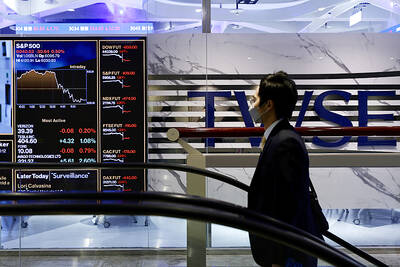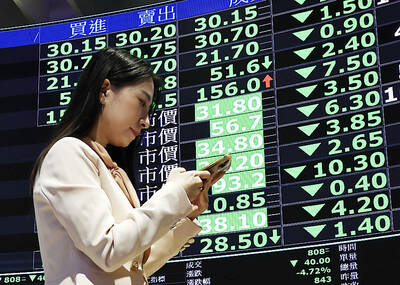Epistar Corp (晶電), the nation’s leading LED chip manufacturer, yesterday announced it is taking aim at the growing micro-LED display industry, saying that over the next one to two years the next-generation chips would start to be used in virtual and augmented reality devices and wearables.
“We are confident, as Epistar and Osram Licht AG are the only two companies in the world that are capable of simultaneously producing red, green, and blue LED, an essential capability in the development of self-luminous micro-LED displays,” Epistar chairman Lee Biing-jye (李秉傑) told reporters before the company’s annual general meeting in the Hsinchu Science Park.
Over the next two years, micro-LED technology will start to be used in devices such as wearables and smartphones, while in three to five years it would be employed in larger devices such as TVs, Lee said.
The technology is expected to start generating significant revenue for Epistar in five years because penetration rates and shipments would take time to grow, Lee said.
Epistar is reportedly co-developing the technology with Apple Inc at a plant in Taoyuan’s Longtan District (龍潭).
Epistar does not give specific information about its clients, Epistar president M.J. Chou (周銘俊) said, but added that it is collaborating with more than one client to develop micro-LED technology.
The development of micro-LED displays involves epitaxial wafers and chips, mass transfer technology and bonding technology, Chou said, adding that the company’s main focus is on producing the epitaxial products.
Epistar is focusing research and development on the development of mass transfer technology, which is important in the fast and accurate mounting onto a display of large numbers of micro-LED chips, Chou said.
“We think that there is potential for micro-LED technology to become the future of the LED industry if it becomes used in smartphones, because every year around the world tens of millions smartphones are shipped,” Chou said.
He declined to disclose the scale of Epistar’s investment in the technology.
Epistar is positive about the company’s business outlook next quarter on increasing orders for the blue/white LED chips used in lighting products and four-element LED products, Chou said.
Citing clients’ order forecasts, Chou said that overall demand for blue/white LED chips has outstripped supply, but added that the situation might change after Chinese peers expand production capacity in the fourth quarter.
Epistar continues to increase the added-value of its products and improve its product portfolio and operational efficiency in an effort to swing its operations back into the black this year, he said.
Epistar last year reported a net loss of NT$3.54 billion (US$116.18 million at the current exchange rate), or NT$3.33 per share.

SELL-OFF: Investors expect tariff-driven volatility as the local boarse reopens today, while analysts say government support and solid fundamentals would steady sentiment Local investors are bracing for a sharp market downturn today as the nation’s financial markets resume trading following a two-day closure for national holidays before the weekend, with sentiment rattled by US President Donald Trump’s sweeping tariff announcement. Trump’s unveiling of new “reciprocal tariffs” on Wednesday triggered a sell-off in global markets, with the FTSE Taiwan Index Futures — a benchmark for Taiwanese equities traded in Singapore — tumbling 9.2 percent over the past two sessions. Meanwhile, the American depositary receipts (ADRs) of Taiwan Semiconductor Manufacturing Co (TSMC, 台積電), the most heavily weighted stock on the TAIEX, plunged 13.8 percent in

A wave of stop-loss selling and panic selling hit Taiwan's stock market at its opening today, with the weighted index plunging 2,086 points — a drop of more than 9.7 percent — marking the largest intraday point and percentage loss on record. The index bottomed out at 19,212.02, while futures were locked limit-down, with more than 1,000 stocks hitting their daily drop limit. Three heavyweight stocks — Taiwan Semiconductor Manufacturing Co (TSMC, 台積電), Hon Hai Precision Industry Co (Foxconn, 鴻海精密) and MediaTek (聯發科) — hit their limit-down prices as soon as the market opened, falling to NT$848 (US$25.54), NT$138.5 and NT$1,295 respectively. TSMC's

TARIFFS: The global ‘panic atmosphere remains strong,’ and foreign investors have continued to sell their holdings since the start of the year, the Ministry of Finance said The government yesterday authorized the activation of its NT$500 billion (US$15.15 billion) National Stabilization Fund (NSF) to prop up the local stock market after two days of sharp falls in reaction to US President Donald Trump’s new import tariffs. The Ministry of Finance said in a statement after the market close that the steering committee of the fund had been given the go-ahead to intervene in the market to bolster Taiwanese shares in a time of crisis. The fund has been authorized to use its assets “to carry out market stabilization tasks as appropriate to maintain the stability of Taiwan’s

In a small town in Paraguay, a showdown is brewing between traditional producers of yerba mate, a bitter herbal tea popular across South America, and miners of a shinier treasure: gold. A rush for the precious metal is pitting mate growers and indigenous groups against the expanding operations of small-scale miners who, until recently, were their neighbors, not nemeses. “They [the miners] have destroyed everything... The canals, springs, swamps,” said Vidal Britez, president of the Yerba Mate Producers’ Association of the town of Paso Yobai, about 210km east of capital Asuncion. “You can see the pollution from the dead fish.